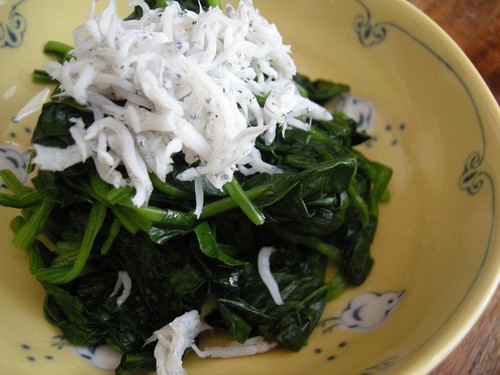
Hey hey, Kayoko here, filling in for Yoko this week. Seems that summer has arrived in the Bay Area (a balmy 77˚F in Oakland, holla!), which means I will only cook meals that take me a few minutes to prepare. Hooray for HOT + LAZY!
A favorite summertime dish on a day like today is
ohitashi, which is essentially just spinach that has been blanched, served cold with a dashi-shoyu broth. It is a staple side-dish on any Japanese breakfast, lunch or dinner table during the hot summer months.
First things first though... is it
oHItashi or
oSHItashi, with an "sh"? You will often find that restaurants spell it in these two different ways, which always drives me nuts. I called Hideko who said, "I think it's
oHItashi... It may have derived from the verb '
hitasu' which means 'to soak', but I'm not positive. Maybe some people accidentally pronounced it with an 'sh' and it stuck?? Whatever, I don't think it matters. I'm busy, I need to go."
Oh, mama.
To further investigate, I called Washi, bartender at Ippuku. He is much more helpful and looked it up for me on the internetz, which told us that it is indeed,
oHItashi.
Alright, with that confirmed, let's prepare
ohitashi.
1.) Wash spinach well, if you buy it by the bunch. Otherwise, the pre-washed bags are pretty dreamy--although 'pre-washed' anything is pretty weird to me. Like 'pre-washed' clothes. Creepy.

2.) Cut spinach.
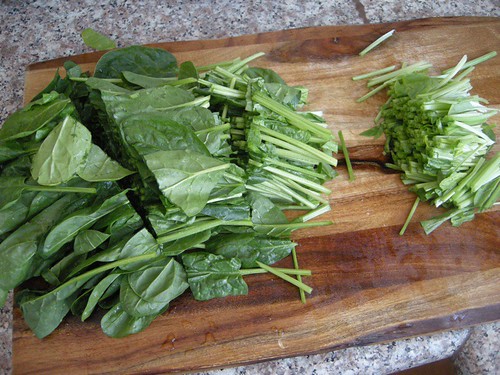
Now, Hideko would probably call this sacrilegious and say that I'm not supposed to cut the spinach before boiling, only after. But I find that it's just easier to cut it up first.
3.) Boil water, then turn the heat off. Then add spinach. I do this so the spinach does not overcook--it really only needs to soak in the hot water for 30 seconds, max.


4.) Drain.
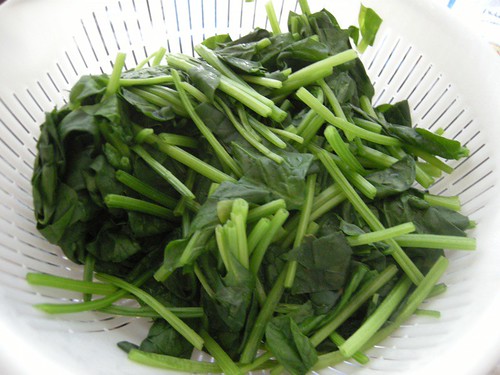
5.) Transfer spinach to an ice bath to "shock" it, and stop it from further cooking (just like you would do with cold noodles). This also gives it good texture.
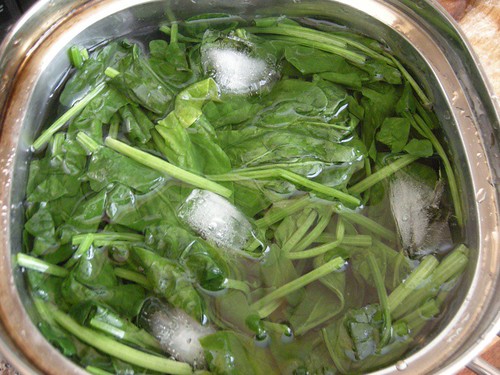
6.) Squeeze out water with hands.
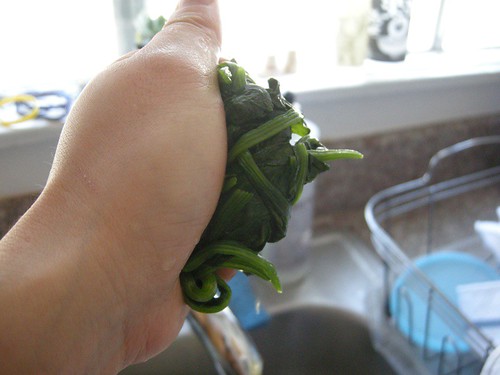
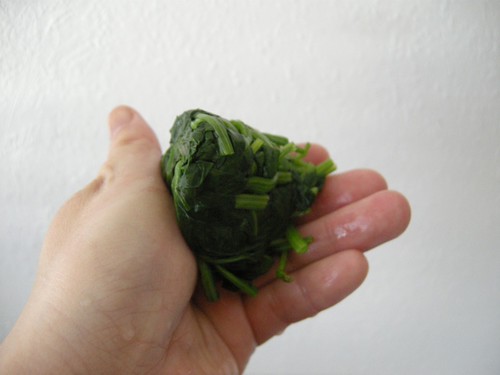
7.) YAH! Such a gorgeous green.
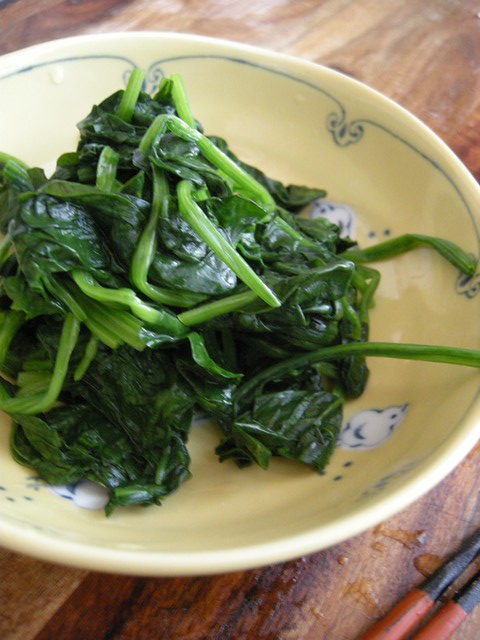
8.) Most traditionally, you will sprinkle some dried bonito flakes over the spinach, then soak it in a refreshing dashi-shoyu broth (4 parts dashi, 1 part soy sauce, 1 part mirin).
However, here I added
shirasu, which are tiny fresh anchovies that you can get at the Japanese grocery store. It's a nice, light pairing to the spinach.

I wanted to add some tartness, so I just added ponzu instead of the requisite dashi-shoyu broth. Do whatever you fancy!
Buon appetito!
 Hey hey, Kayoko here, filling in for Yoko this week. Seems that summer has arrived in the Bay Area (a balmy 77˚F in Oakland, holla!), which means I will only cook meals that take me a few minutes to prepare. Hooray for HOT + LAZY!
A favorite summertime dish on a day like today is ohitashi, which is essentially just spinach that has been blanched, served cold with a dashi-shoyu broth. It is a staple side-dish on any Japanese breakfast, lunch or dinner table during the hot summer months.
First things first though... is it oHItashi or oSHItashi, with an "sh"? You will often find that restaurants spell it in these two different ways, which always drives me nuts. I called Hideko who said, "I think it's oHItashi... It may have derived from the verb 'hitasu' which means 'to soak', but I'm not positive. Maybe some people accidentally pronounced it with an 'sh' and it stuck?? Whatever, I don't think it matters. I'm busy, I need to go."
Oh, mama.
To further investigate, I called Washi, bartender at Ippuku. He is much more helpful and looked it up for me on the internetz, which told us that it is indeed, oHItashi.
Alright, with that confirmed, let's prepare ohitashi.
1.) Wash spinach well, if you buy it by the bunch. Otherwise, the pre-washed bags are pretty dreamy--although 'pre-washed' anything is pretty weird to me. Like 'pre-washed' clothes. Creepy.
Hey hey, Kayoko here, filling in for Yoko this week. Seems that summer has arrived in the Bay Area (a balmy 77˚F in Oakland, holla!), which means I will only cook meals that take me a few minutes to prepare. Hooray for HOT + LAZY!
A favorite summertime dish on a day like today is ohitashi, which is essentially just spinach that has been blanched, served cold with a dashi-shoyu broth. It is a staple side-dish on any Japanese breakfast, lunch or dinner table during the hot summer months.
First things first though... is it oHItashi or oSHItashi, with an "sh"? You will often find that restaurants spell it in these two different ways, which always drives me nuts. I called Hideko who said, "I think it's oHItashi... It may have derived from the verb 'hitasu' which means 'to soak', but I'm not positive. Maybe some people accidentally pronounced it with an 'sh' and it stuck?? Whatever, I don't think it matters. I'm busy, I need to go."
Oh, mama.
To further investigate, I called Washi, bartender at Ippuku. He is much more helpful and looked it up for me on the internetz, which told us that it is indeed, oHItashi.
Alright, with that confirmed, let's prepare ohitashi.
1.) Wash spinach well, if you buy it by the bunch. Otherwise, the pre-washed bags are pretty dreamy--although 'pre-washed' anything is pretty weird to me. Like 'pre-washed' clothes. Creepy.
 2.) Cut spinach.
2.) Cut spinach.
 Now, Hideko would probably call this sacrilegious and say that I'm not supposed to cut the spinach before boiling, only after. But I find that it's just easier to cut it up first.
3.) Boil water, then turn the heat off. Then add spinach. I do this so the spinach does not overcook--it really only needs to soak in the hot water for 30 seconds, max.
Now, Hideko would probably call this sacrilegious and say that I'm not supposed to cut the spinach before boiling, only after. But I find that it's just easier to cut it up first.
3.) Boil water, then turn the heat off. Then add spinach. I do this so the spinach does not overcook--it really only needs to soak in the hot water for 30 seconds, max.

 4.) Drain.
4.) Drain.
 5.) Transfer spinach to an ice bath to "shock" it, and stop it from further cooking (just like you would do with cold noodles). This also gives it good texture.
5.) Transfer spinach to an ice bath to "shock" it, and stop it from further cooking (just like you would do with cold noodles). This also gives it good texture.
 6.) Squeeze out water with hands.
6.) Squeeze out water with hands.

 7.) YAH! Such a gorgeous green.
7.) YAH! Such a gorgeous green.
 8.) Most traditionally, you will sprinkle some dried bonito flakes over the spinach, then soak it in a refreshing dashi-shoyu broth (4 parts dashi, 1 part soy sauce, 1 part mirin).
However, here I added shirasu, which are tiny fresh anchovies that you can get at the Japanese grocery store. It's a nice, light pairing to the spinach.
8.) Most traditionally, you will sprinkle some dried bonito flakes over the spinach, then soak it in a refreshing dashi-shoyu broth (4 parts dashi, 1 part soy sauce, 1 part mirin).
However, here I added shirasu, which are tiny fresh anchovies that you can get at the Japanese grocery store. It's a nice, light pairing to the spinach.
 I wanted to add some tartness, so I just added ponzu instead of the requisite dashi-shoyu broth. Do whatever you fancy!
Buon appetito!
I wanted to add some tartness, so I just added ponzu instead of the requisite dashi-shoyu broth. Do whatever you fancy!
Buon appetito!




Comments (4)
I have always heard that east side Tokyo people say “shi” vs. “hi.” So sometimes you hear people say “shito” for person “hito.” People on the west side will say “hito,” and people on the east sometimes say “shito.”
actually you can read about it on Japanese Wikipedia, entry “Edo kotoba” 江戸言葉
http://ja.wikipedia.org/wiki/%E6%B1%9F%E6%88%B8%E8%A8%80%E8%91%89#.E3.80.8C.E3.82.B7.E3.80.8D.E3.81.A8.E3.80.8C.E3.83.92.E3.80.8D.E3.81.AE.E6.B7.B7.E5.90.8C
The specifically talk about this issue:
「シ」と「ヒ」の混同
“The ‘shi’ and ‘hi’ mixup/confusion”
If you look at the kanji “hi” is the correct pronunciation.
Omg this is hilarious. I’m gonna do some investigating and listen closely to how Kunio vs. Hideko pronounce this. Kunio is a downtown Tokyo man, I bet he says “shi”. I love this!
My late grandfather also had the same problem. He used to say “Oshitashi” “Shito darake” (There are too many people). I wish I could hear him say that one more time..((